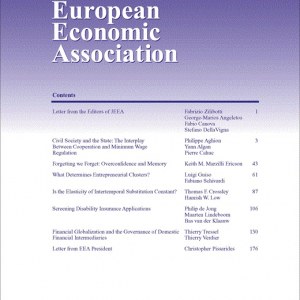
Fafchamps, M., Goyal, S. and van der Leij, M.J. (2010). Matching and network effects Journal of the European Economic Association, 8(1):203--231.
-
Affiliated authorMarco van der Leij
-
Publication year2010
-
JournalJournal of the European Economic Association
The matching of individuals in teams is a key element in the functioning of an economy. The network of social ties can potentially transmit important information on abilities and reputations and also help mitigate matching frictions by facilitating interactions among 'screened' individuals. We conjecture that the probability of two individuals forming a team falls in the distance between the two individuals in the network of existing social ties. The objective of this paper is to empirically test this conjecture. We examine the formation of coauthor relations among economists over a twenty-year period. Our principal finding is that a new collaboration emerges faster among two researchers if they are 'closer' in the existing coauthor network among economists. This proximity effect on collaboration is strong: Being at a network distance of 2 instead of 3, for instance, raises the probability of initiating a collaboration by 27%.